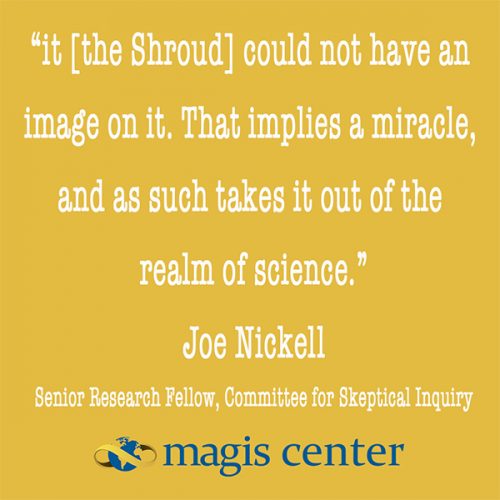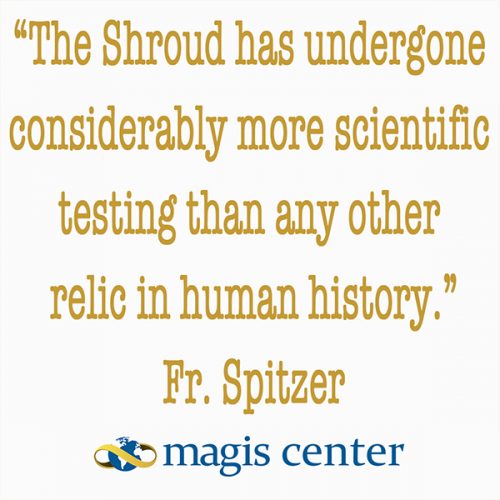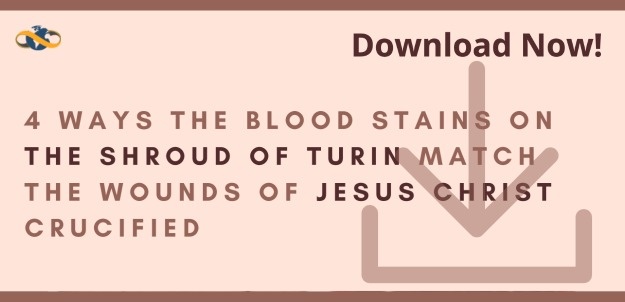Whether questioning or defending the authenticity and date of its origins or attempting to offer a “scientific” explanation for the cause of the image itself, the Shroud of Turin has generated an enormous amount of research and literature.
Recently, at the Napa Institute’s Annual Conference, Fr. Spitzer highlighted 5 key pieces of scientific evidence regarding the Shroud’s authenticity and traced its likely journey from 1st century Palestine to its well-documented appearance in Lirey, France, in 1349.
Here are some of the highlights of that presentation.
New evidence has come to light in recent years concerning the following:
- Problems with the 1988 carbon dating.
- Four new tests – Dr. Raymond Rogers and Dr. Giulio Fanti – give date of 50 A.D.
- External evidence – Dr. Max Frei (pollen grains); Drs. Whanger and Haralick (Roman coins).
- Sudarium Christi.
- Evidence of the resurrection.

Problems with the 1988 Carbon Dating
In 1989, the results of 3 independent labs examining a sample of the Shroud taken from the lower left corner caused shockwaves even among agnostic investigators. Their findings indicated a date in the 1300’s. Since the publication of their findings in 1989, however, several problems have been documented concerning the protocol the researchers used. These include:
- The sample of cloth used by the three labs came from the same location on the Shroud, contrary to the protocol set up by STURP which recommended 7 sampling sites with each sample to be sent to 7 different labs.
- The sample of cloth used for the carbon dating (known as the Raes sample) is not of the same composition of other areas of the Shroud. In fact, Joseph Marino and Sue Benford show that there are 16th Century fibers woven into the Raes samples and in the sample taken for the 1988 carbon dating (immediately above the Raes samples) – 2000.
- Raymond Rogers conducted further research on the contested sample and offered the following conclusion:
“The combined evidence from chemical kinetics, analytical chemistry, cotton content, and pyrolysis/mass spectrometry proves that the material from the radiocarbon area of the Shroud is significantly different from that of the main cloth.The radiocarbon sample was thus not part of the original cloth and is invalid for determining the age of the Shroud.”
Four New Dating Tests
Fr. Spitzer also mentioned 4 new dating tests which have as a midpoint of the average a date of 50 A.D. (plus or minus 200 years) with a 96% confidence level.
- Dr. Max Frei’s pollen grains – Judea origin.
- Dr. Alan Whanger’s and Robert Haralick’s digital photographic analysis of the roman coins on the eyes of the man in the Shroud–minted by Pontius Pilate in 29 A.D. in Judea.
- Sudarium Christi (facecloth of Christ) has similar pollen grains.
The Sudarium of Oviedo
Known also as the Sudarium Christi (the face cloth of Christ), it does not bear an image, but it has blood and serum stains consistent with the patterns and blood type (AB) of the Shroud of Turin. The length of the nose on both cloths is 8 centimeters (3 inches). These similarities indicate the high probability that they touched the same face: a crucified man who was crowned with thorns.
Evidence of the Resurrection
One of the most intriguing and elusive questions about the Shroud is how the image was formed. Fr. Spitzer discussed five anomalies concerning the image itself:
- Precise photographic negative (on non-photographically sensitive cloth).
- Image not produced by paint, dye, vapors, or scorching.
- Image is restricted to uppermost part of fibrils (does not penetrate to medulla of fiber). There is no other image like it. Cause is rapid dehydration.
- The blood imprints precede the formation of the image.
- 3D imaging on SHROUD (e.g. bones inside the hand and flesh surrounding the bone).
The only known explanation for the formation of the image is an intense burst of vacuum ultraviolet radiation (equivalent to the output of 14,000 excimer lasers) emitted from every three-dimensional point of the body in the Shroud.

An “Undocumented” Journey: A Trail of Pollen
Well documented historical records are an elusive component of many ancient manuscripts and artifacts. Many times, provenance is a historian’s “best guess”. Fr. Spitzer offered the following lines of evidence tracing the probable journey of the Shroud from Jerusalem to Edessa, Turkey, and from Edessa to Constantinople, from Constantinople to Lirey, France in 1350. Pollen grains confirm its presence in each of these places!
Evidence of Origins in Jerusalem
Two pieces of evidence support the Shroud’s origins in Jerusalem. Four of the greatest number of pollen grains found on the cloth are unique to Judea. Secondly, in-depth analysis of the Roman coins found over the eyes in the image reveals that they were indeed minted by Pontius Pilate in 29 A.D. in Jerusalem.
From Jerusalem to Edessa, Turkey (400 - 943 AD)
The second largest number of pollen grains – 3 indigenous to Edessa--confirm that the Shroud was in Edessa Turkey. It is believed that the relic known as the Mandylion was the Shroud folded into a frame so that only the face showed. The Shroud not only shows creases from being folded in a frame, but 20 peculiarities in the face of the Shroud’s image appear at this time in the iconography of Jesus in Edessa.
From Edessa to Constantinople (943 - 1204 AD)
Assuming that the Mandylion is the Shroud, it is known that in 943 AD the Emperor Lacapenus laid siege to Odessa to get the Mandylion (holy image).
Additionally, testimony from Crusaders, particularly explicit testimony from Robert deClari, indicate that the Mandylion was in Hagia Sophia and St. Mary Blachernae.
Again, found on the Shroud, there are pollen grains from Constantinople – 2 indigenous to that region. After the Mandylion is moved to the emperor’s palace, reports from the 11th century include mention not only of the Mandylion but of a full Shroud. In 1204, the Shroud disappears from Constantinople.
From Constantinople to Lirey France
Geoffrey de Charny is the first documented owner of the Shroud. We know from his testimony that the Shroud of today made its appearance in Lirey, France by 1349. Charnay was married to Jeanne de Vergy, a 5th generation descendent of Othon de la Roche, a high leader of the 4th crusade. It is likely to have been in the possession of her family from 1204 AD until that time.
After that time, the Shroud’s provenance is well secured: Lirey, France to the fire of Chambery (1532) to Turin, Italy (1578).
So although there remains a certain miraculous quality to the formation of the image, the 1978 STURP Investigation and subsequent scientific investigations have been remarkably thorough, and with the exception of the questionable 1988 carbon dating, all the evidence-including the trail of pollen grains-points to the Shroud being the burial cloth of Jesus.


